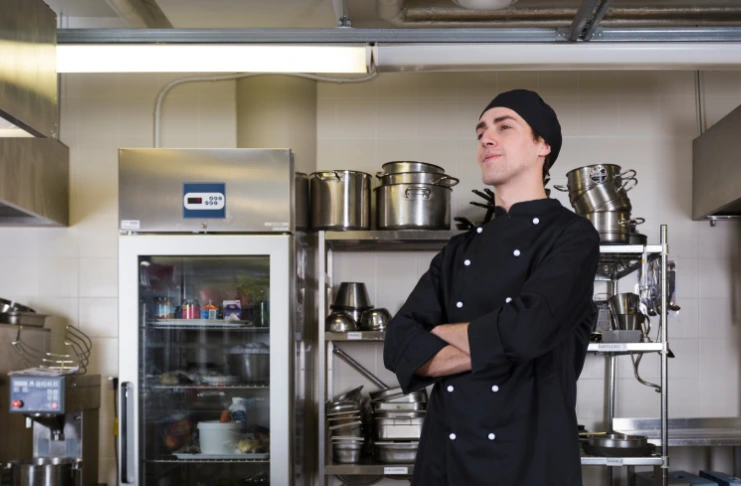The restaurant industry is rapidly evolving with rising demand for online food delivery and the need to cut costs. The process of setting up a cloud kitchen offers a cost-effective, scalable solution by eliminating dine-in spaces and focusing solely on delivery. Also known as ghost kitchens or virtual kitchens, cloud kitchens reduce overheads like front-of-house staff and real estate.
Whether you’re a new food entrepreneur or an established restaurateur, mastering the cloud kitchen operations workflow is essential to building a successful cloud kitchen business. This guide covers everything—from planning and licensing to kitchen layout, staffing, tech integration, and branding. Learn how to run a cloud kitchen efficiently with proven strategies and a detailed operational checklist for cloud kitchen management.
Start building your future-ready food delivery business today by optimizing your online food ordering system, the setup process of your ghost kitchen, and operations for maximum growth.
What is a Cloud Kitchen?

The setup process involves creating a delivery-only kitchen, also called a ghost or virtual kitchen. These kitchens focus solely on food preparation without dine-in, streamlining the cloud kitchen operations workflow for efficient delivery.
The popularity of cloud kitchens has surged dramatically over the past few years, driven by the constraints of physical space :
- Lower startup and operational costs compared to traditional restaurants
- Flexibility to experiment with multiple food concepts under one roof
- Data-driven operations that enable quick adaptation to market trends
- The explosive growth of food delivery platforms worldwide
This cloud kitchen model cuts overhead and boosts agility in today’s competitive food market. By mastering how to run a cloud kitchen efficiently, following an operational checklist for cloud kitchen success, and developing a solid business strategy, you can achieve rapid growth and lasting profitability.
The Setup Process: A Step-by-Step Approach

When setting up a cloud kitchen business, which is a delivery only restaurant, you need to make sure a 100 different things, like what equipments to buy, how to set up your food delivery services, what staff to hire, how to market and reach customers, all the while staying within your budget and keeping lower overhead costs. Below is a step-by-step approach for all restaurant owners to start their own cloud kitchen business.
Phase 1: Planning and Research
Before launching your kitchen, the setup process must begin with strategic planning, and understanding local regulations– market research, budgeting, and location selection are essential to building a strong cloud kitchen operations workflow.
Market Research and Concept Development
The process begins with thorough market research. Identify gaps in your local delivery market, like the availability of delivery drivers, that your virtual kitchen can fill. Ask yourself:
- What cuisine types are underrepresented in your area?
- Which food categories perform best on delivery platforms?
- What are the price points that work well for delivery in your location?
This insight drives your concept development and helps you attract customers while positioning your brand to succeed within a competitive cloud kitchen operations workflow.
Financial Planning and Budgeting
Strong financial planning is key to running a cloud kitchen efficiently. While initial costs are lower than those of traditional restaurant businesses, cloud kitchens still require upfront investment. Your budget should account for:
- Kitchen lease and setup costs
- Equipment purchases
- Initial inventory expenses
- Staffing costs
- Marketing budget
- Technology infrastructure
- Licensing and permits
- Contingency funds (at least 15-20% of your total budget)
A structured financial plan ensures clear goals, helps track your burn rate, and drives strategies to attract more customers as part of your operational checklist for cloud kitchen success.
Location Selection
Though cloud kitchens don’t need prime retail locations or a traditional dine-in space, choosing the right space remains critical to your operation’s success. Even without dine-in service, location impacts performance. The ideal location should:
- Be centrally positioned within your target delivery radius
- Have adequate kitchen ventilation capabilities
- Offer sufficient electrical capacity for commercial equipment
- Provide easy access for delivery partners
- Include loading areas for supply deliveries
- Meet all local zoning requirements for commercial food preparation
Remember that the right location, alongside effective partnerships with other local delivery services, supports faster deliveries and smoother workflows, forming a critical part of your setup process.
Phase 2: Legal and Compliance Requirements
Navigating legal and compliance requirements is a critical step in the process. Getting your business structure, permits, and food safety standards right ensures smooth operations and long-term success.
Business Registration and Structure
Establishing your cloud kitchen’s legal structure is a crucial step in the setup process. Choosing the right business structure impacts your liability, taxes, and operational workflow. Common options include:
- Sole proprietorship: The simplest form, but it offers no liability protection.
- Limited Liability Company (LLC): Provides liability protection along with tax flexibility, ideal for many cloud kitchens.
- Corporation: Ensures complete separation of personal and business liability, suitable for larger operations.
- Partnership: Useful if launching your cloud kitchen with multiple owners.
It’s wise to consult a business attorney to identify the best legal structure that aligns with your goals and risk tolerance, ensuring smooth cloud kitchen operations workflow from day one, especially when coordinating with your local delivery service.
Food Service Licenses and Permits
Operating a cloud kitchen requires full compliance with food safety regulations, just like traditional restaurants. As part of your operational checklist for a cloud kitchen, secure all necessary permits, including:
- Business license
- Food service establishment permit
- Food handler’s permits for all staff
- Health department certification
- Fire department permit
- Alcohol license (if applicable)
Because requirements vary by location, consult your local health department and business licensing office to avoid legal pitfalls and maintain an efficient cloud kitchen operations workflow within the food industry.
Food Safety Compliance
Strict food safety standards are non-negotiable in the process of setting up any food business. Implement a comprehensive food safety management system that covers:
- Temperature control during storage, preparation, and delivery
- Cross-contamination prevention protocols
- Allergen management procedures
- Staff hygiene requirements
- Cleaning and sanitization schedules
- Pest control measures
- Waste management procedures
To ensure your team is fully prepared to run a cloud kitchen efficiently, consider having key staff members obtain food safety certifications which strengthens your operation’s commitment to food safety, enhances your service quality, and supports your marketing efforts, streamlining your cloud kitchen operations workflow.
Phase 3: Physical Setup and Infrastructure
Designing the perfect kitchen layout and selecting the right equipment are two crucial steps in the setup process. Together, they ensure smooth operations and help you run a cloud kitchen efficiently from day one.
Kitchen Layout Design
An efficient kitchen layout design is essential for maximizing productivity in the process. A well-planned layout ensures a seamless flow from ingredient storage to final packaging, reducing unnecessary movement and eliminating bottlenecks. Key factors to consider include:
- Clear separation of preparation, cooking, and packaging zones
- Strategic placement of equipment to minimize cross-traffic
- Adequate storage for dry goods, refrigerated, and frozen items
- Designated areas for order assembly and handoff to delivery personnel
- Space planning for multiple brands or concepts within one kitchen
Engaging professional kitchen planners can optimize your space to support an efficient cloud kitchen operations workflow tailored to your menu and business model.
With a smart kitchen layout in place, you can move on to selecting the essential equipment for your cloud kitchen.
Essential Equipment Selection
Choosing the right equipment is a critical step in the setup of a cloud kitchen. Your equipment needs depend on your menu, but most cloud kitchens require:
- Commercial refrigeration and freezers
- Cooking ranges and ovens
- Fryers and grills (as needed)
- Food processors and mixers
- Preparation tables and workstations
- Ventilation systems
- Packaging station equipment
- Dishwashing facilities
- Fire suppression systems
Opt for energy-efficient equipment to lower long-term costs and evaluate whether leasing or purchasing aligns better with your financial goals to run your cloud kitchen efficiently.
Once your equipment is chosen, the next vital component is building a robust technology infrastructure to streamline operations.
Technology Infrastructure
Technology plays a vital role in streamlining the workflow of cloud kitchen operations. Essential technology components include:
- Point of Sale (POS) system integrated with delivery platforms
- Kitchen Display System (KDS) for order management
- Inventory management software
- Staff scheduling tools
- Financial tracking and reporting systems
- Customer relationship management (CRM) software
- Reliable internet connection with backup options
- Security cameras and monitoring systems
Selecting technology solutions that integrate seamlessly will reduce manual errors and improve overall efficiency, helping you run a cloud kitchen efficiently from day one.
A strong technology infrastructure completes the core elements of an effective cloud kitchen setup.
Phase 4: Cloud Kitchen Operations Workflow Development
To successfully run a cloud kitchen efficiently, it’s essential to implement systems that streamline your order flow, production processes, inventory control, and team management—each playing a key role in a seamless cloud kitchen operations workflow.
Order Management System
An efficient order management system is the backbone of any successful cloud kitchen operations workflow. To run a cloud kitchen efficiently, your system should:
- Integrate seamlessly with all delivery platforms you use
- Consolidate orders into a single dashboard
- Automatically prioritize orders based on preparation time and delivery distance
- Track order status from receipt to handoff
- Enable easy communication with delivery personnel
- Provide real-time updates to customers
- Generate meaningful data for operational analysis
By streamlining your order handling process, you reduce errors, accelerate output, and boost customer satisfaction—an essential item on your operational checklist for cloud kitchen success.
Kitchen Production Flow
Optimizing your kitchen production flow is crucial to maintaining speed, consistency, and food quality in the cloud kitchen. Ensure your production workflow includes:
- Immediate order receipt and digital confirmation
- Efficient ingredient prep and station handoff
- Precision cooking and finishing steps
- Rigorous quality checks before packaging
- Proper labeling and tamper-proof packaging
- Smooth coordination with delivery partners
Well-defined kitchen protocols help you run a cloud kitchen efficiently by minimizing delays and ensuring consistent food quality, keeping your workflow lean and productive.
Inventory Management
Smart inventory management can make or break your profitability in the cloud kitchen industry. Build systems that support:
- Daily and weekly inventory audits
- Just-in-time restocking to reduce spoilage
- Reliable supplier partnerships and backup vendors
- Menu optimization based on seasonal ingredient availability
- Portion control and cost standardization
- Waste monitoring and food cost analysis
Use digital inventory tools to automate this process and maintain a data-driven approach, strengthening your overall cloud kitchen operations workflow and improving bottom-line performance.
Staff Training and Management
Your team plays a pivotal role in how well you can run a cloud kitchen efficiently. Create a structured training program that covers:
- Menu-specific food prep and cooking techniques
- Quality control and food presentation standards
- Compliance with food safety regulations
- Operation of your kitchen technology stack
- Understanding of your order management system and delivery protocols
- Proper packaging and labeling practices
- Customer service guidelines for indirect delivery interactions
Cross-training staff ensures flexibility, reduces disruptions, and strengthens the operational checklist for cloud kitchen functionality.
Phase 5: Menu Engineering for Delivery Success
Mastering the cloud kitchen setup process means perfecting menu design, packaging, and pricing to streamline your cloud kitchen operations workflow and run efficiently.
Delivery-Friendly Food Development
Not all foods travel well, making menu development a crucial consideration in the cloud kitchen setup process. Focus on creating dishes that:
- Maintain quality during transit time
- Package efficiently without leaking or spilling
- Can be easily reheated if necessary
- Present well upon arrival
- Offer good value for the price point
Test each menu item by ordering it yourself and evaluating its condition after a typical delivery time frame to ensure customer satisfaction—this step is essential for refining your cloud kitchen operations workflow.
Recipe Standardization
Consistency is paramount in cloud kitchen operations. Create detailed recipe cards that include:
- Exact ingredient quantities
- Step-by-step preparation instructions
- Cooking temperatures and times
- Plating and presentation guidelines
- Packaging specifications
- Quality control checkpoints
- Common troubleshooting tips
Use visual aids like photos or videos to supplement written instructions, particularly for complex or signature dishes. This practice supports how to run a cloud kitchen efficiently and minimizes variability.
Packaging Solutions
The right packaging enhances both food quality and brand perception. Consider:
- Temperature retention properties for hot and cold items
- Sustainability and environmental impact
- Branding opportunities on packaging
- Ease of use for customers
- Stackability for efficient delivery
- Leak and spill prevention
- Cost-effectiveness
Test multiple packaging options before making bulk purchases to ensure they meet your specific requirements.
Pricing Strategy
Developing an effective pricing strategy involves balancing multiple factors:
- Food and packaging costs (aim for 25-30% of menu price)
- Labor expenses
- Delivery platform commissions (typically 15-30%)
- Competitor pricing
- Customer price sensitivity in your market
- Psychological pricing tactics (e.g., $9.99 vs. $10)
- Bundle and combo opportunities
Regularly review and adjust pricing based on ingredient cost fluctuations and market response to maintain profitability across your food business.
Phase 6: Marketing and Brand Development
For effective cloud kitchen operations workflow, a strong online presence, optimized delivery platforms, and smart customer strategies are key to driving growth and retention.
Online Presence Establishment
Building a strong online presence is essential for cloud kitchen success. Develop:
- A professionally designed website with your menu, story, and ordering options
- Social media profiles focused on platforms where your target audience is active
- Professional food photography highlighting your signature dishes
- Engaging content that showcases your food quality and preparation process
- Local SEO optimization to appear in relevant searches
- Google Business profile with complete information
Consistent branding across all platforms helps build recognition and trust with potential customers.
Delivery Platform Optimization
Most cloud kitchens generate significant business through third-party delivery platforms. Optimize your listings by:
- Creating compelling menu descriptions with appropriate keywords
- Using high-quality food photography for all items
- Setting up special offers and promotions
- Responding promptly to customer reviews (both positive and negative)
- Analyzing performance data to refine your offerings
- Managing your availability hours accurately
- Keeping pricing and menu items current across all platforms
Consider starting with 1-2 platforms before expanding to ensure you can maintain service quality during the initial launch phase.
Customer Acquisition and Retention Strategies
Developing both acquisition and retention strategies is crucial to sustainable growth. Consider:
- Introductory offers for first-time customers
- Loyalty programs rewarding repeat orders
- Referral incentives encouraging word-of-mouth marketing
- Limited-time specials to create urgency
- Bundle deals to increase average order value
- Targeted email marketing for special occasions
- Personalized thank-you notes or small extras with orders
Track customer lifetime value to determine how much you can afford to spend on acquisition while maintaining profitability.
Phase 7: How to Run a Cloud Kitchen Efficiently
To master how to run a cloud kitchen efficiently, tracking KPIs, streamlining operations, and maintaining strong financial management are essential for long-term success.
INDUSTRY INSIGHT
| 83% of customers feel more loyal to brands that actively respond to and resolve their complaints, highlighting that strong customer service is a key driver of brand loyalty and long-term value. A robust Customer Relationship Management (CRM) system becomes essential. In a cloud kitchen setup, where there’s no face-to-face interaction—CRM helps track customer feedback, respond promptly to issues, personalize communication, and build loyalty over time. By centralizing customer data and automating engagement, CRM tools ensure consistent service quality, boost repeat orders, and maximize customer lifetime value, making the cloud kitchen model more efficient and profitable. |
Key Performance Indicators (KPIs)
Monitoring the right metrics is essential to running a cloud kitchen efficiently. Track:
- Average order value
- Order acceptance rate
- Order preparation time
- On-time delivery percentage
- Food cost percentage
- Labor cost percentage
- Customer ratings and reviews
- Repeat customer rate
- Revenue per square foot
- Platform-specific performance metrics
Establish baseline expectations for each metric and develop improvement plans for any areas falling below targets.
Operational Optimization Techniques
Continuous improvement should be part of your operational culture. Implement:
- Regular time-motion studies to identify workflow bottlenecks
- Cross-training programs to enhance team flexibility
- Prep scheduling optimization to minimize waste
- Rush hour preparation strategies
- Equipment maintenance schedules to prevent breakdowns
- Packaging station efficiency reviews
- Regular menu performance analysis
Small incremental improvements across multiple areas compound to create significant operational gains over time.
Financial Management Best Practices
Sound financial management ensures long-term sustainability. Focus on:
- Weekly profit and loss reviews
- Cash flow projections and management
- Vendor payment optimization
- Labor scheduling based on sales forecasts
- Menu engineering to promote high-margin items
- Inventory turnover monitoring
- Cost control measures for utilities and supplies
- Regular pricing reviews and adjustments
Consider working with an accountant experienced in food service businesses to establish optimal financial systems.
Phase 8: Scaling Your Cloud Kitchen Operation
After streamlining the cloud kitchen’s setup, one should focus on scalable strategies like multi-brand models, geographic growth, and tech integration to expand efficiently.
Multi-Brand Development
One advantage of the cloud kitchen model is the ability to operate multiple brands from one facility. When considering expansion:
- Develop complementary concepts that can share ingredients and equipment
- Create distinctive branding for each concept to avoid confusion
- Ensure kitchen staff can efficiently produce all menus during peak times
- Implement clear order management systems to separate different brand orders
- Analyze cross-selling opportunities between your brands
- Test new concepts with limited menus before full launches
Start with your core concept and add additional brands only after achieving operational stability.
Geographic Expansion
As your operation proves successful, you might consider geographic expansion by:
- Identifying underserved neighborhoods with strong delivery demand
- Setting up satellite kitchens in strategic locations
- Partnering with existing kitchen facilities for shared space arrangements
- Creating hub-and-spoke distribution models for efficiency
- Adapting menus to local preferences while maintaining brand consistency
- Building localized marketing campaigns for each new area
Carefully analyze the unit economics of each potential location before committing to expansion.
Technology Integration for Growth
As you scale, technology becomes increasingly important to maintain consistency and control. Consider:
- Centralized inventory management across multiple locations
- Standardized recipe databases accessible to all kitchens
- Consolidated reporting dashboards for multi-unit oversight
- Automated purchasing systems linked to inventory levels
- Integrated customer data platforms across all brands and locations
- Performance benchmarking tools for location comparison
A study reports that 77% of restaurants experienced increased efficiency, reduced staff pressure, lower costs, and higher revenue after adopting technological solutions. Invest in scalable systems from the beginning to avoid costly transitions as you grow.
Operational Checklist for Cloud Kitchen: Daily, Weekly, and Monthly Tasks

Running a cloud kitchen efficiently requires a clear setup process and a well-organized cloud kitchen operations workflow. A detailed operational checklist helps maintain quality, control costs, and boost team performance every day.
Daily Operational Checklist for Cloud Kitchen
A well-structured daily routine is essential for cloud kitchens to maintain high standards, ensure food safety, and deliver seamless service. To ensure smooth service and food safety, daily tasks are essential. These include:
- Place preparation and staff briefing
- Equipment inspection and ingredient quality checks
- Monitoring order acceptance and delivery handoff efficiency
- Regular temperature checks and sanitization verification
- Mid-day inventory spot checks and customer feedback reviews
- Closing procedures like cleaning, equipment shutdown, and sales review
Following these daily steps is key to maintaining consistency and meeting customer expectations.
Weekly Operational Tasks
Effective inventory, staff management, and marketing are key to smooth cloud kitchen operations. Weekly tasks focus on these to keep the cloud kitchen running efficiently:
- Complete inventory counts and supplier order placements
- Food cost analysis and waste reduction planning
- Staff performance reviews, scheduling, and training refreshers
- Social media content scheduling and promotion implementation
- Customer engagement and competitor analysis
These efforts strengthen your team, reduce costs, and grow your customer base.
Monthly Strategic Tasks
Regular financial, menu, and operational reviews are key to running a cloud kitchen efficiently. Monthly reviews allow strategic adjustments for sustained growth and profitability:
- Financial analysis, including profit and loss statements and labor cost optimization
- Menu engineering with sales mix analysis, new item testing, and pricing reviews
- Operational assessments covering equipment maintenance, technology review, and vendor evaluations
- Safety audits and staff satisfaction checks
Regular monthly evaluations ensure your cloud kitchen adapts to market needs and runs at peak efficiency.
Consistently following this comprehensive checklist enables cloud kitchens to optimize workflows, enhance customer satisfaction, and drive sustainable growth.
Tips for Running a Cloud Kitchen Efficiently

Boost your cloud kitchen operations workflow by leveraging technology, optimizing space, and implementing effective cost control strategies for maximum efficiency and profitability.
Technological Efficiency Boosters
Leveraging technology can dramatically improve your workflow in cloud kitchen operations. Consider implementing:
- Integrated POS Systems: Choose systems that seamlessly connect with all your delivery platforms, reducing manual order entry and potential errors.
- Kitchen Display Systems (KDS): Digital ticket systems eliminate paper waste and improve communication between preparation stations.
- Automated Inventory Management: Software that tracks ingredient usage in real-time helps prevent stockouts and reduces overstocking.
- Predictive Analytics: Use historical data to forecast busy periods, optimize staffing, and prepare accordingly.
- Customer Data Management: Systems that track customer preferences enable personalized marketing and improved retention.
These technological investments typically pay for themselves through improved efficiency and reduced waste.
Space Optimization Techniques
Cloud kitchens often operate in limited spaces, making optimization essential:
- Vertical Storage Solutions: Utilize wall space and overhead areas for storage of infrequently used items.
- Multi-purpose Equipment: Select versatile equipment that can perform multiple functions rather than single-purpose tools.
- Modular Workstations: Create flexible preparation areas that can be reconfigured based on changing needs.
- Time-sharing Stations: Schedule different menu concepts to use the same equipment at different times when running multiple brands.
- Smart Kitchen Layout: Design your space to minimize staff movement between storage, preparation, cooking, and packaging areas.
Regular workflow analysis can identify bottlenecks and opportunities for layout improvements.
Cost Control Strategies
Maintaining tight cost control is crucial for cloud kitchen profitability:
- Portion Control Systems: Implement standardized portioning tools and regular staff training to prevent overserving.
- Supplier Negotiation: Regularly review and negotiate with multiple suppliers to ensure competitive pricing.
- Energy Management: Install energy-efficient equipment and develop protocols for turning off unused equipment.
- Cross-utilization of Ingredients: Design menus across concepts to use shared ingredients, reducing waste and simplifying inventory.
- Dynamic Pricing: Adjust prices based on demand periods, ingredient costs, and competitor positioning.
- Labor Scheduling Optimization: Use historical order data to schedule staff precisely when needed, avoiding overstaffing during slow periods.
Small improvements in cost control across multiple areas can significantly impact your bottom line.
Common Challenges in the Process and How to Overcome Them

Effective delivery management, strong staff retention, and consistent quality control are essential components of a successful cloud kitchen and pose constant challenges in one’s journey.
Delivery Logistics Management
Delivery timing and quality are critical to customer satisfaction. Address common challenges by:
- Establishing Clear Pickup Procedures: Create a dedicated space for delivery partners with clear order identification systems.
- Staggering Order Preparation: Time cooking based on estimated driver arrival to ensure food freshness.
- Packaging Innovation: Invest in packaging that maintains food temperature and quality during transit.
- Delivery Radius Optimization: Limit your delivery area to ensure food arrives in optimal condition.
- Direct Delivery Fleet: Consider developing your own delivery capability for greater control over the customer experience.
89% of consumers are more likely to make another purchase after a positive customer service experience. Regular communication with delivery partners about challenges and solutions helps improve the overall system.
Staff Retention and Motivation
The high-pressure environment of cloud kitchens can lead to staff turnover. Improve retention by:
- Creating Clear Career Paths: Define advancement opportunities to strengthen your cloud kitchen operations workflow.
- Performance-Based Incentives: Develop bonus systems tied to operational metrics and customer satisfaction.
- Positive Work Environment: Despite the lack of customer interaction, foster team camaraderie and celebration of achievements.
- Ongoing Skills Development: Provide regular training opportunities to enhance culinary and technical skills.
- Work-Life Balance Consideration: Structure shifts to avoid burnout and accommodate personal needs when possible.
Investing in your team builds operational stability and consistency, which directly impacts customer satisfaction.
Quality Consistency Maintenance
Maintaining consistent quality is particularly challenging in delivery-only models. Address this by:
- Detailed Recipe Documentation: Standardize your cloud kitchen operations workflow with step-by-step recipe guides and preparation stage photos.
- Regular Blind Tastings: Order anonymously from your own kitchen to evaluate what customers truly experience.
- Quality Control Checkpoints: Add multiple verification points throughout the prep process—part of a strong operational checklist for a cloud kitchen.
- Temperature Monitoring Systems: Use smart tools to keep food at optimal temperatures, which are critical for safety and consistency.
- Customer Feedback Integration: Implement systems that swiftly convert feedback into actionable improvements.
Making quality a team-wide priority is key to running a cloud kitchen efficiently and maintaining operational excellence.
Future Trends in Cloud Kitchen Operations

The cloud kitchen landscape continues to evolve rapidly. Stay ahead in the cloud kitchen business by monitoring trends like:
- Automation Integration: Robotic cooking assistants and automated preparation systems are becoming increasingly affordable and capable.
- Sustainability Focus: Eco-friendly packaging, food waste reduction programs, and energy-efficient operations are growing priorities.
- Direct-to-Consumer Models: Reducing dependency on third-party delivery platforms through proprietary apps and marketing channels.
- Ghost Grocery Expansion: Adding grocery items and meal kits to traditional prepared food offerings.
- Virtual Brand Partnerships: Collaborations with celebrities, influencers, and established brands to create exclusive virtual concepts.
- Data-Driven Menu Development: Using artificial intelligence to analyze ordering patterns and optimize menu offerings in real-time.
Staying informed about industry developments helps you adapt your setup process and operations to remain competitive.
Conclusion
The rise of cloud kitchens is reshaping the restaurant industry by prioritizing agility, digital integration, and delivery-focused operations. Successfully mastering the setup process and optimizing your cloud kitchen operations workflow are crucial for building a scalable and profitable food business. By following a comprehensive operational checklist—covering licensing, kitchen layout, staffing, technology, and compliance—you create a solid foundation for efficiency and growth. Implementing effective strategies on how to run a cloud kitchen efficiently helps you maximize resources, maintain consistent food quality, and exceed customer expectations. Whether you’re launching a new virtual brand or expanding an existing operation, embracing the innovation and streamlined processes of cloud kitchens is essential to thriving in today’s fast-paced, digital-first food delivery market.
Frequently Asked Questions
1. How do I set up my cloud kitchen?
Choose a suitable location, get necessary licenses, equip with kitchen tools, and partner with delivery platforms.
2. Can I open a cloud kitchen in the USA?
Yes, cloud kitchens are legal and growing rapidly across the USA.
3. How much space do you need for a cloud kitchen?
Typically, you need 300 to 1,000 square feet, depending on the scale and menu for a cloud kitchen.
4. What does CloudKitchens do?
Cloud Kitchens provide shared kitchen spaces optimized for delivery-only food businesses.
5. What is the kitchen operations process?
The kitchen operation process involves order receiving, food preparation, packaging, and dispatch for delivery.
6. How does CloudKitchens work?
They lease kitchen space with tech-enabled infrastructure for delivery-focused restaurants.
7. What is kitchen workflow?
The sequence of tasks is from ingredient prep to cooking, packaging, and order dispatch.
8. How to manage cloud kitchen?
Focus on streamlined operations, quality control, tech integration, and timely delivery.
9. How do I make my cloud kitchen successful?
Optimize menu, maintain quality, use data-driven marketing, and ensure fast delivery.
10. How much can a cloud kitchen make?
Earnings vary widely but can range from $100K to over $1M annually with good management.
11. Does location matter for cloud kitchen?
Yes, proximity to high-demand areas and delivery zones is crucial.
12. What do you need for a kitchen checklist?
You need equipment, safety gear, inventory, licenses, cleaning supplies, and staff training for your kitchen.
13. What is SOP in Cloud Kitchen?
A Standard Operating Procedure (SOP) detailing consistent steps for food prep, hygiene, and delivery.
14. What are the operations of a kitchen?
Procurement, storage, food prep, cooking, packaging, cleaning, and order management are various operations of a kitchen.





